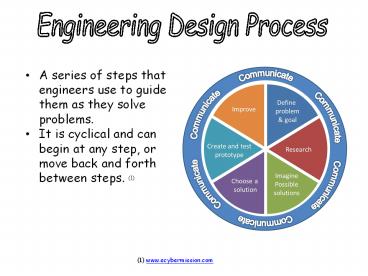Engineering Design Process - PowerPoint PPT Presentation
Title:
Engineering Design Process
Description:
A series of steps that engineers use to guide them as they solve problems. It is cyclical and can begin at any step, or move back and forth between steps. – PowerPoint PPT presentation
Number of Views:401
Avg rating:3.0/5.0
Title: Engineering Design Process
1
Engineering Design Process
- A series of steps that engineers use to guide
them as they solve problems. - It is cyclical and can begin at any step, or move
back and forth between steps. (1)
(1) www.ecybermission.com
2
Engineer
- A person trained and skilled in the design,
construction, and use of a system or machine. - Needs to be well versed in language arts, as well
as math and science
Engineering Fields Engineering Fields
Mechanical Aerospace
Electrical Nuclear
Chemical Civil
Biomedical Computer
3
Innovation vs. Invention
- Invention
- A device or process originated after study and
experiment
- Innovation
- A new improvement to an existing device or
process
Image taken from http//www.novuslight.com/led-ma
rket-phasing-in_N239.html
Image taken from http//lexpower.wordpress.com/20
10/07/21/chronological-order-show-me-the-timeline/
1000px-bicycle_evolution-en-svg/
4
Engineering Design Process
Communicate
Define problem goal
Improve
Communicate
Create and test prototype
Research
Communicate
Communicate
Imagine Possible solutions
Choose a solution
Communicate
Click on a slice of the Engineering Design
Process cycle to learn more about its parts
5
Define problem and goal
- Identify and describe the issue and the ultimate
objective
- Consider
- What do you want to accomplish?
- What are the requirements?
- Are there any limitations?
- Who is the customer?
6
Research
- Gather information and investigate existing
technologies related to the problem - Talk to individuals who share this problem and
could benefit from possible solutions
7
Imagine possible solutions
- Brainstorm ideas.
- Be creative and build upon the ideas of others.
- Explore and compare many possible designs within
your group. - Be open-minded!
8
Choose a solution
- What materials and tools are needed?
- Consider environmental, cultural, time, and
financial issues and constraints. - Select the most feasible idea and assign team
tasks.
9
Create test prototype
- Build a protoype
- Protoype - an operating version of a solution.
It is often made with different materials
(cheaper and easier to work with) than the final
version. They allow you to test your solution and
supply feedback. (2) - Push yourself and the group for creativity,
imagination, and excellence in design.
(2)http//www.sciencebuddies.org/engineering-desi
gn-process/engineering-design-prototypes.shtml
10
Improve
- Share results and continue to seek how your team
could make the solution better. - Iterate your design to make the product the best
it can be. - Iterate - to repeat an already completed task to
incorporate new information (3)
(3) Ulrich K., Eppinger S. 2000. Product Design
and Development. 2nd Edition. Irwin McGraw-Hill,
Boston.































